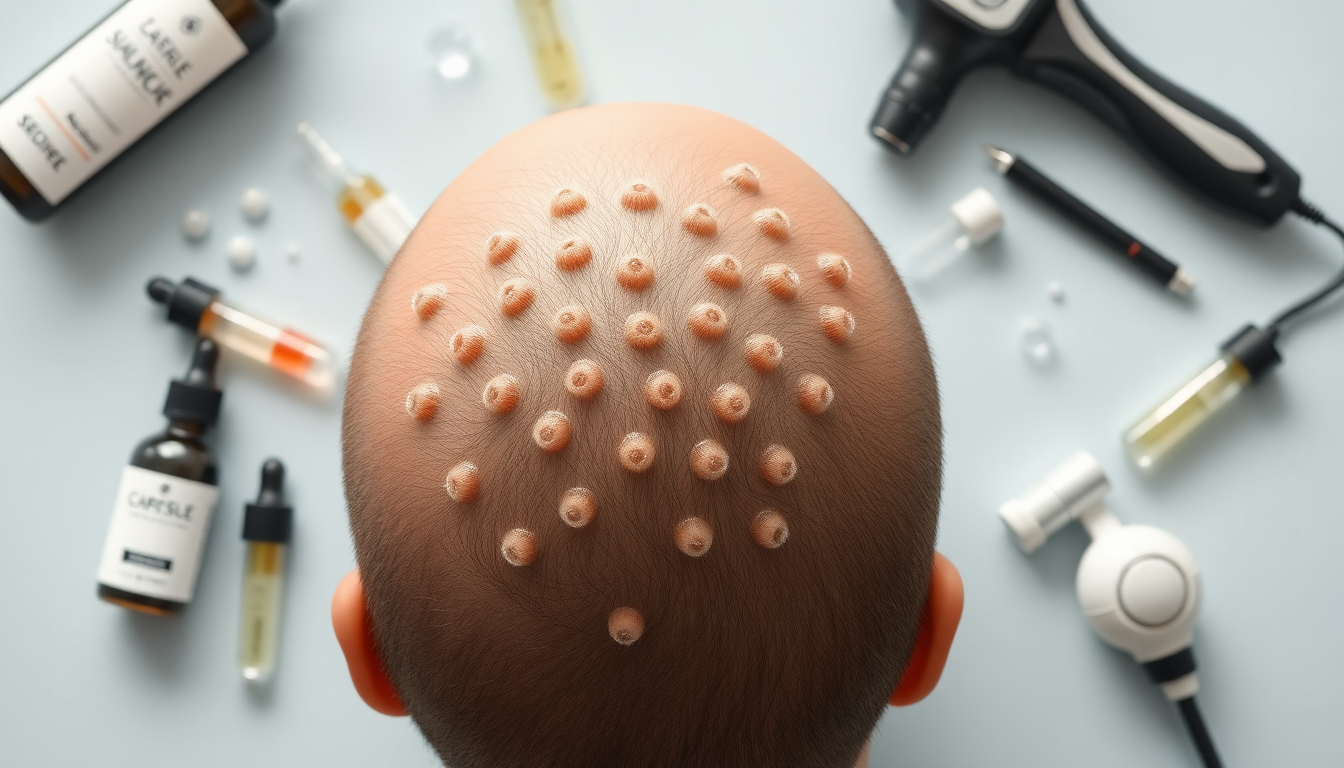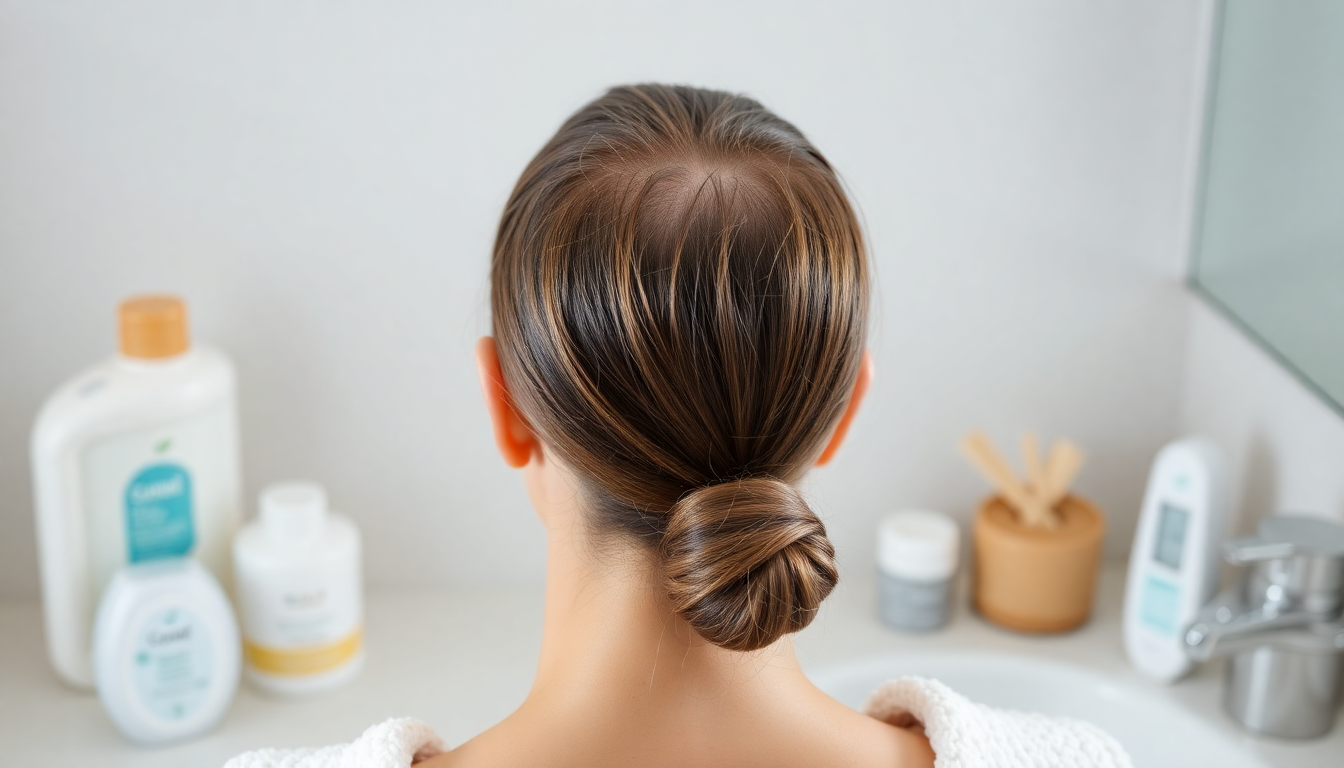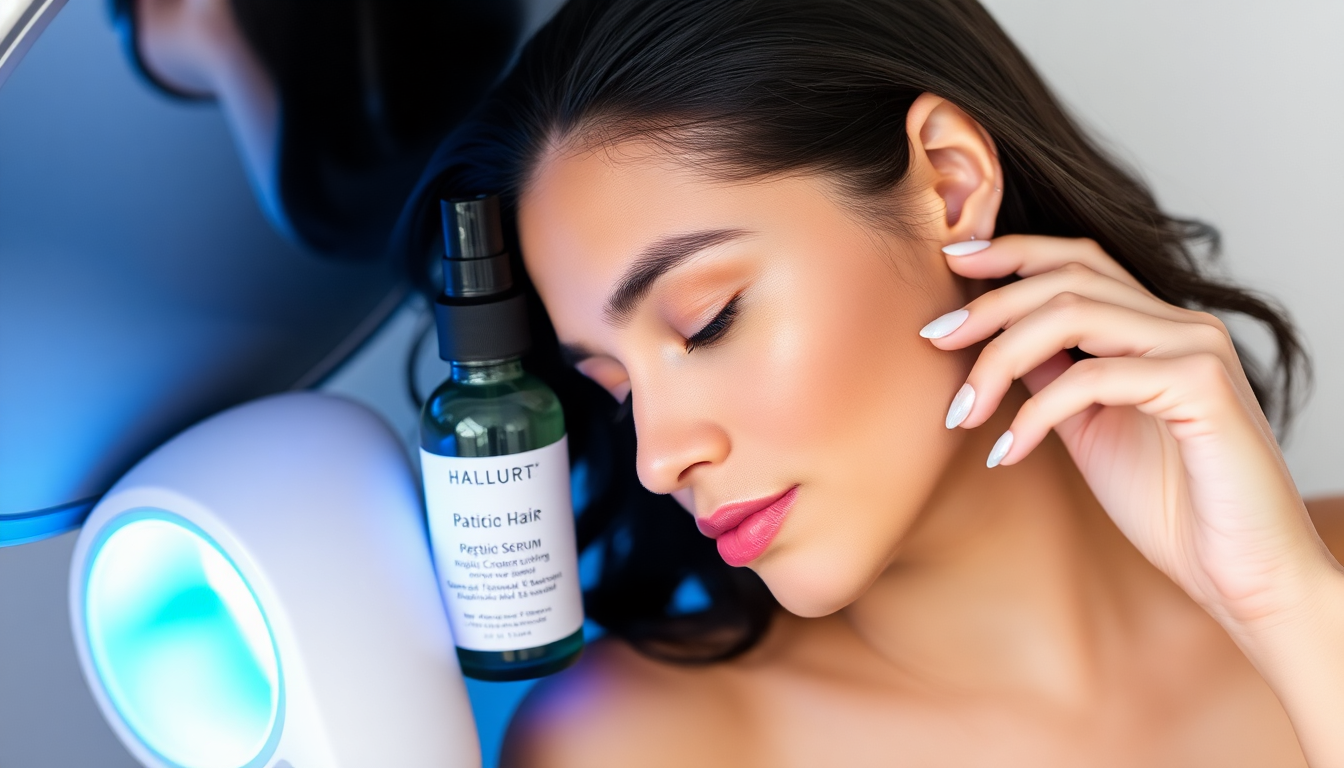Introduction: Why a Personalized Scalp Protocol Wins
Generic hair advice often misses the root cause (literally): the scalp. When you tailor a protocol that combines peptide serums, prebiotic microbiome support, and complementary at-home devices, you stack mechanisms that target follicle signaling, inflammation control, and delivery/ circulation. The result: optimized conditions for thicker, stronger hair over time. This long-form guide walks you through the science, product selection, device pairing, protocols for common hair-loss scenarios, and a practical plan you can follow and adapt.
How Hair Grows: A Quick Science Refresher
- Anagen (growth) phase: active follicle produces hair shaft.
- Catagen (transition) phase: follicle shrinks and hair growth pauses.
- Telogen (resting/shedding) phase: hair sheds and the cycle restarts.
Thickening strategies either extend anagen, increase shaft diameter, reduce shedding, or improve overall scalp conditions so follicles perform optimally.
Mechanisms of the Three Pillars
- Peptide serums — provide signaling molecules (e.g., copper peptides, biomimetic growth-factor peptides) that support keratin production, extracellular matrix remodeling, and follicle health.
- Prebiotic treatments — feed beneficial microbes, help control scalp inflammation and sebum balance, and support barrier function so actives work in a less hostile environment.
- At-home devices — microneedling increases topical uptake; LLLT stimulates cellular activity and circulation; sonic massagers increase blood flow and relieve tension.
Deep Dive: What Peptides Actually Do
Peptides are short amino acid chains designed to mimic or stimulate biological signals. For scalp thickening, look for:
- GHK-Cu (copper peptide): associated with wound healing, matrix remodeling and reported to support hair growth signals.
- Palmitoyl peptides (palmitoyl tetrapeptide-3, palmitoyl tetrapeptide-7): often used to mimic growth-factor activity.
- Biomimetic peptides that resemble naturally occurring follicle growth factors.
Formulation matters: peptides need stable carriers, appropriate pH, and lightweight vehicles for scalp penetration. Avoid heavy occlusive oils when your goal is follicular absorption.
Prebiotics vs. Probiotics for the Scalp
Prebiotics are selectively fermented ingredients that feed beneficial microbes already present on the scalp. They:
- Help normalize microbiome composition, reducing dysbiosis linked to inflammation.
- Can reduce itchiness, flaking and oil imbalance that interfere with growth.
- Are often formulated as serums or leave-on treatments with ingredients like inulin, fructooligosaccharides, and plant-derived oligosaccharides.
Probiotics (live microbes) can be sensitive in formulations and may have storage constraints; prebiotics are more shelf-stable and easier to integrate.
At-Home Device Types & How They Help
- Microneedling (dermaroller/pen): micro-injuries stimulate repair pathways and temporarily increase topical absorption. Typical scalp home-usage depths range 0.25–0.5 mm for serums; deeper treatments are clinician-administered.
- Low-Level Laser Therapy (LLLT): red/near-infrared light improves cellular ATP production and may increase anagen phase duration. Devices range from combs to helmets.
- Sonic/vibrational scalp massagers: improve circulation and product distribution; gentle daily use often helps with product uptake and scalp relaxation.

How to Choose Products: Evidence-Forward Checklist
- Look for clinically tested ingredients and transparent concentrations on peptide labels whenever possible.
- Prefer pH-balanced prebiotic treatments designed for scalp use (pH 4.5–5.5).
- Check device safety: FDA clearance for LLLT devices is a strong signal; for microneedling, use medical-grade tools and clear depth info.
- Read ingredient lists: avoid high levels of alcohol or fragrances if you have sensitivity.
Step-by-Step Protocol Building Guide (Extended)
Use this decision tree to design your regimen.
- Step A — Define goal: density, thickness, or reduced shedding?
- Step B — Identify scalp status: oily, dry, inflamed, flaking?
- Step C — Select a peptide serum with suitable potency and vehicle (spray/serum/oil-free drop).
- Step D — Pick a prebiotic treatment that complements the peptide (water-based, lightweight).
- Step E — Choose a device based on tolerance and lifestyle (LLLT daily vs microneedle weekly).
Detailed Routines for Specific Conditions
Male Pattern Hair Loss (Androgenetic)
- Primary aim: increase shaft thickness and slow miniaturization. Combine peptide serum daily with LLLT (5–20 minutes/day) and a prebiotic 2–3x/week to control inflammation.
- Microneedling 0.5 mm every 1–2 weeks can be added if tolerated; always coordinate with any prescription treatments with your clinician.
Female Pattern Hair Thinning
- Women often benefit from gentle daily peptides and prebiotics. LLLT helmets or caps for 15–30 minutes several times weekly are convenient for busy schedules.
- Address hormonal or nutritional contributors with a clinician if diffuse thinning persists.
Telogen Effluvium (Post-Stress / Postpartum)
- Focus on scalp recovery: prebiotic treatments to calm microbiome and inflammation; lightweight peptides to support follicle signaling.
- LLLT can speed recovery by stimulating cellular activity; avoid aggressive microneedling within the first months of acute shedding.
Scalp Sensitivity, Dermatitis, or Seborrheic Tendencies
- Prioritize anti-inflammatory and fragrance-free formulations. Introduce one new product at a time and patch-test.
- Use low-frequency device schedules and shorter LLLT sessions (5–10 minutes) to avoid irritation.
Full Example Protocols — Day-by-Day, Month-by-Month
Below are two 12-week progress plans you can adapt. Always document your baseline before starting.
12-Week Beginner Protocol (Balanced Approach)
- Weeks 1–2: Patch-test peptide serum and prebiotic. Use peptide every other day, prebiotic 2x/week. LLLT for 5–10 minutes every other day.
- Weeks 3–6: Increase peptide to daily if no irritation. LLLT 10–15 minutes daily or every other day. Introduce microneedling 0.25 mm once weekly before peptide application if tolerated.
- Weeks 7–12: Continue daily peptide, prebiotic 2–3x/week, LLLT 15 minutes daily. Evaluate photos at 8 and 12 weeks; consider increasing microneedle depth to 0.5 mm only if you have experience and no irritation.
12-Week Aggressive Protocol (High Tolerance, Clinician-Approved)
- Weeks 1–2: Introduce peptide serum daily and prebiotic every other day. LLLT daily 15–20 minutes. No microneedling for first 2 weeks.
- Weeks 3–8: Start microneedling 0.5 mm once weekly, applying peptide serum immediately after. Continue LLLT daily. Maintain scalp hydration and sun protection.
- Weeks 9–12: Assess photographic progress. Maintain regimen or cycle to recovery weeks to avoid overstimulation.
Layering Rules: Timing, Order & Interactions
- Cleanse when needed. A clean scalp improves uptake but avoid over-cleansing that strips lipids.
- If using a prebiotic and a peptide, apply the prebiotic first if it's water-based and allow 1–3 minutes to absorb; then apply peptide.
- Microneedle on a clean, dry scalp, then apply peptide serum within minutes for maximum uptake.
- LLLT can be used before or after topical application — many prefer after serum application so light penetrates with enhanced topical contact. Follow your device manual.
How to Read Labels & Avoid Marketing Hype
- Ingredient order matters: higher concentration ingredients appear earlier in the list.
- 'Peptide complex' is vague — check for named peptides (GHK-Cu, palmitoyl tetrapeptide, etc.).
- 'Microbiome-friendly' claims are common; prefer products that list specific prebiotic ingredients (inulin, FOS) and pH information.
- For devices, look for clinical data or independent user studies when possible.
Supplements, Lifestyle & Diet — Supporting Players
- Ensure adequate protein intake and key micronutrients (iron, zinc, vitamin D, B12, biotin where indicated) — test before supplementing high doses.
- Manage stress and sleep — telogen effluvium is commonly stress-related.
- Avoid harsh chemical processing and high-heat styling while running an active scalp protocol.
Advanced Troubleshooting
- Increased shedding early on: could be normal telogen shift or reaction — document and reassess at 8–12 weeks.
- Persistent redness after introducing LLLT or microneedling: pause devices and seek dermatologic advice.
- Plateau after 4–6 months: reassess concentrations, consider alternating peptides or consulting a clinician for adjunct medical therapies.
Measuring Success — Metrics That Matter
- Standardized photos (same lighting, camera, angle) every 4 weeks.
- Hair pull test (clinician-guided) and hair-counting in a fixed area if you want more precise measures.
- Scalp health metrics: reduced flaking, normalized sebum, less itch — these early wins often precede visible thickening.
Real-World Case Examples (Anonymized)
- Case A — Mild female diffuse thinning: started with daily peptide spray and prebiotic mist, LLLT 15 minutes 5x/week. At 4 months, improved volume and reduced part width; scalp less oily.
- Case B — Male early pattern hair loss: used peptide serum, microneedling 0.5 mm biweekly, LLLT daily; after 6 months noticed improved shaft diameter and slower progression.
Shopping Guide & Recommended Features
- Peptide serum: named peptides (GHK-Cu, palmitoyl peptides), lightweight carrier, explicit scalp-use labeling.
- Prebiotic treatment: lists inulin, FOS, or plant oligosaccharides; pH info and low fragrance.
- Devices: LLLT with clearance or published safety; microneedling with medical-grade needles and clear depth labeling.
For a practical starting point, consider testing a clinically minded peptide hair serum and pairing it with a dedicated prebiotic scalp treatment. These targeted options can help you streamline your regimen and give you a consistent baseline for progress (sponsored links).

FAQ — Quick Answers to Common Questions
- Q: How soon will I see results?
A: Scalp health may improve within 4–8 weeks. Noticeable thickening often takes 3–6 months, and up to a year for substantial changes. - Q: Can I use scalp retinoids to increase absorption?
A: Retinoids increase turnover and can elevate irritation risk. Avoid combining strong retinoids with microneedling without clinical supervision. - Q: Are natural oils helpful?
A: Occlusive oils can trap peptides and limit absorption. Use oils for conditioning and not immediately before peptide application if penetration is the goal.
Storage, Shelf Life & Practical Tips
- Store peptide serums in a cool, dark place; some benefit from refrigeration if the label recommends it.
- Record purchase and open dates; most serums are best within 6–12 months after opening depending on preservatives.
- Replace microneedling heads as recommended and sanitize devices per manufacturer guidance.
Ethical & Safety Note
This guide provides general information and practical recommendations. It does not replace personalized medical evaluation. If you have active scalp infections, severe dermatitis, or significant medical hair loss, consult a dermatologist before starting devices or concentrated actives.
Putting It Together: A Practical 30-Day Kickstart Plan
- Week 1: Patch-test both peptide serum and prebiotic; LLLT 5–10 minutes 3x/week; document baseline photos.
- Week 2: If no irritation, increase peptide to every other day, prebiotic to 2x/week, LLLT 10–15 minutes 4–5x/week.
- Week 3–4: Move peptide to daily if tolerated; start weekly microneedling 0.25 mm only if no scalp sensitivity; continue prebiotic and LLLT schedule. Re-photo at day 30.
Where to Buy Targeted, Scalp-Focused Formulations
Reliable lines that focus specifically on scalp absorption, peptide actives and microbiome-targeted prebiotics help reduce guesswork. For example, Eelhoe offers scalp-targeted peptide hair serum and a complementary prebiotic scalp treatment engineered for easy layering in multi-step protocols (sponsored links). Consider these as starting points when building your routine.
Conclusion — Start Smart, Track Progress, Adjust
Combining peptide serums, prebiotic scalp treatments and targeted at-home devices gives you a flexible toolkit to support hair thickening. The keys to success are clear: assess your scalp, choose compatible products, start slowly with devices, and document progress objectively. Patience and consistency matter — visible changes typically take months.
If you want a streamlined starting kit, explore Eelhoe's range of scalp-targeted formulations. Their peptide hair serum and prebiotic scalp treatment are designed to pair well in layered protocols and can help you accelerate early improvements. Visit Eelhoe's hair growth products to browse options and start building your custom scalp protocol today (sponsored links).
Final Safety Reminder
This article is for informational purposes and does not constitute medical advice. If you have significant or rapidly worsening hair loss, scalp disease, or are on medications, consult a healthcare provider or dermatologist before starting new active treatments or devices.




Yorum yazın
Tüm yorumlar yayınlanmadan önce incelenir.
Bu site hCaptcha ile korunuyor. Ayrıca bu site için hCaptcha Gizlilik Politikası ve Hizmet Şartları geçerlidir.